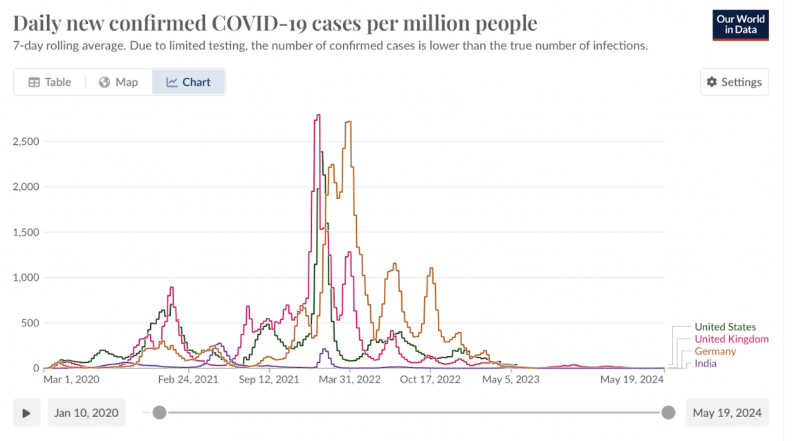
Deborah Birx is at it again, urging mass testing for the detection of bird flu. She wants cows and dairy workers examined to ferret out asymptomatic infections and exposures in animals and people. We have the technology so why not use it, she demands to know. We are making the same mistake we made with Covid early on, she argues.
The role of testing is relatively uncontroversial but it probably should be. Early on in the Covid crisis, though completely against the lockdowns, I was an enthusiast for testing simply because I thought doing so would overcome the epistemic void that was driving public panic.
If you are scared of a disease and have no means to discover whether or not you have it, what is your choice but to hop around in a frenzy and comply with every edict? That was my thinking in any case. We live and learn.
What’s left out of the testing issue is the great question of why. Is it track, trace, and isolate? That has been proven impossible – and long known to be impossible – in the case of a fast-spreading and fast-mutating respiratory virus with a zoonotic reservoir. They tried it anyway with many states quickly hiring tens of thousands of contract tracers.
The iTunes and Google app stores had contract tracing programs you could download. That way if you came close to someone who had tested positive, you would be alerted. It worked like a digital leper’s bell. In fact, even now, the airlines are still doing Covid contact tracing for flying in and out of the country.
Another possible rationale is likely the one in the mind of Birx. She was formed in the AIDS era where the goal was zero infections. Early on, she was a proponent of zero Covid and made that very clear. She is a virus exterminationist: every policy is structured to drive infections, cases, and even exposure to zero, despite the utter impossibility of this goal.
Another possible rationale would be to discern early intervention therapies for people who need them. But realizing that goal is contingent on two other conditions: having therapeutics available and knowing with some sense of confidence that an asymptomatic infection is certainly going to get worse.
Think of the movie Contagion (2011) in this way. It was a killer virus that you get and get worse and then die, all rather quickly. In the movie, the job of the health authorities was always to find the infected and notify everyone with whom they had contact. By the way, this didn’t even work in the film but we are presented with some impressive disease forensics that ended up isolating patient zero.
Again, the question beckons: why are we doing all this? The goals of stopping the spread, driving exposure to zero, and actually treating the sick (if they are sick versus just exposed) are certainly in tension with each other. If you are going to embark on an elaborate and invasive scheme to find and isolate every instance of the pathogen, it’s a good idea to know what precisely you are trying to achieve with the effort. No interviewer has been smart enough to ask this fundamental question of Birx.
And keep in mind that Birx does not want to limit testing to people. She wants cows and chickens tested too, and there’s no particular reason to limit it to that. It could include every member of the animal kingdom, every four-legged creature, and every fish and foul. The expense would be enormous and truly unthinkable, driving the cost of meat production sky-high, especially given the inevitable slaughters that would be mandated.
This is made worse, as we learned last time, by PCR tests that can be set at any cycle rate to discover the mere presence of a virus in just about anything. The last time, this led to unwarranted assumptions of contagiousness, up to 90 percent in 2020, as reported by the New York Times. Because there was and is so much confusion about this piece, let’s quote it directly.
The PCR test amplifies genetic matter from the virus in cycles; the fewer cycles required, the greater the amount of virus, or viral load, in the sample. The greater the viral load, the more likely the patient is to be contagious.
This number of amplification cycles needed to find the virus, called the cycle threshold, is never included in the results sent to doctors and coronavirus patients, although it could tell them how infectious the patients are.
In three sets of testing data that include cycle thresholds, compiled by officials in Massachusetts, New York and Nevada, up to 90 percent of people testing positive carried barely any virus, a review by The Times found.
On Thursday, the United States recorded 45,604 new coronavirus cases, according to a database maintained by The Times. If the rates of contagiousness in Massachusetts and New York were to apply nationwide, then perhaps only 4,500 of those people may actually need to isolate and submit to contact tracing.
While it’s not quite precise to say that the PCR tests generate 90% false positives, it is correct to say that in those tests looked at by the NYT at the height of the pandemic, 90 percent of positive results did not warrant concern at all. They should have been thrown out entirely.
That’s a serious problem for the test, track, trace, and isolate regime that Birx is proposing. Is it any wonder that people today are highly suspicious of this entire idea? Rightly so. Nothing is to be gained by throwing the whole of society into a mysophobic panic when the tests themselves are so poor at discerning the difference between a mild exposure and a medically significant case.
For more on this, see my interview with Jay Bhattacharya, who was onto this problem very early on.
Indeed it was precisely the PCR tests that created this wild confusion between an exposure, an infection, and an actual case. The word case in the past had been reserved for someone actually sick and needing some medical intervention. For reasons never explained, that entire language was blown up, such that OurWorldinData suddenly started listing every documented PCR exposure as a case, creating the feeling of disaster when actually life was functioning entirely normally. The better the authorities got at testing, and the more universal the testing mandates, the sicker the population seemed to be getting.
This all depends on the conflation of exposure, infection, and cases.

Once the disease panic is created, what’s left to do about it remains entirely within the realm of public health authorities. Already last week, the authorities ordered 4 million chickens to be slaughtered. Already more than 90 million birds have been killed since 2022.
As Joe Salatin points out: “The policy of mass extermination without regard to immunity, without even researching why some birds flourish while all around are dying, is insane. The most fundamental principles of animal husbandry and breeding demand that farmers select for healthy immune systems. We farmers have been doing that for millennia. We pick the most robust specimens as genetic material to propagate, whether it’s plants, animals, or microbes.”
This is precisely where this obsession with testing gets us. Whether it is animals or humans, the power of government to compel disease tests and act on the results has led to destructive policies in every instance. You might think we would have learned. Instead, reporters just let Birx ramble on without asking fundamental questions about severity, purpose, viability, or consequences.
There has probably in the history of government never been a more presumptuous aspiration than for bureaucrats to seek to manage the whole of the microbial kingdom. But that is where we are. There’s never been a better time for every citizen of a would-be free nation to proclaim: my biology is none of the government’s business.
Disclaimer
Some of the posts we share are controversial and we do not necessarily agree with them in the whole extend. Sometimes we agree with the content or part of it but we do not agree with the narration or language. Nevertheless we find them somehow interesting, valuable and/or informative or we share them, because we strongly believe in freedom of speech, free press and journalism. We strongly encourage you to have a critical approach to all the content, do your own research and analysis to build your own opinion.
We would be glad to have your feedback.
Source: Brownstone Institute Read the original article here: https://brownstone.org/

